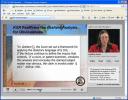The USPTO is developing a Continuing Education for Practitioners (“CEP”) system for on-line delivery of educational materials for patent practitioners. The goal of this whole business — according to the USPTO — is to increase efficiency, reduce pendency, and improve quality in the patent process.
For now, the USPTO trying out the system in a limited pilot program so we signed up to see what the scoop is. Basically, the CEP program presents brief educational materials concerning recent USPTO rule changes, revised patent examination guidelines, or the like. The practitioner (that’s us) will have to respond to “verification questions” after reviewing the educational materials.
The verification questions are drawn from the training material and the practitioner has access to the educational material while responding to the questions. In other words, the verification questions are designed to verify you have actually viewed the materials instead of playing on-line poker (not that we’d do that, of course); they are not a test of knowledge or skills.
According to the literature, the total time spent reviewing the educational materials and responding to verification questions should be approximately one hour. Practitioners would be required to complete one CEP program per year. No fee will be charged to access the training materials (yippee!) and a fee would accrue only for failing to timely complete the training.

While the training materials gloss over the fact that KSR introduced yet more undefined terms like “real innovation” while continuing to lack definition for “obvious,” the introduction points out that the program covers only guidelines for Examiners to help determine obviousness [see Examination Guidelines published 10/10/07]. The guidelines are NOT substantive rulemaking. So, the failure of an Examiner to follow the guidelines is neither appealable nor petitionable.
I have to admit, the last thing we like to hear is “Hey, how about spending more time not billing?” However, given that the CEP will only require one hour per year (and at no cost), we think the program could provide a lot of benefit with minimal cost.
We’ll report back on our progress.
